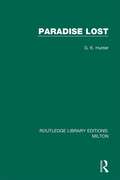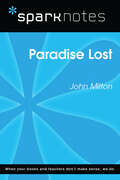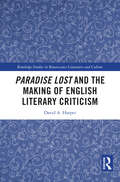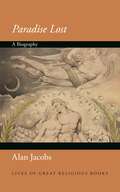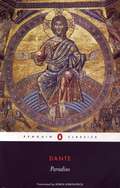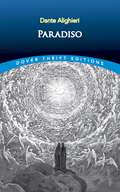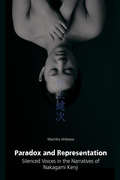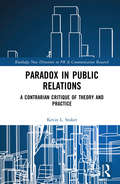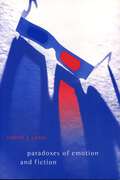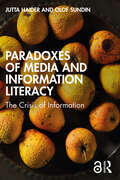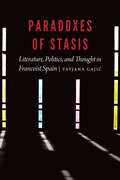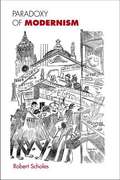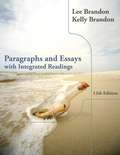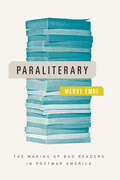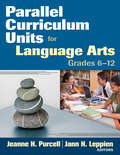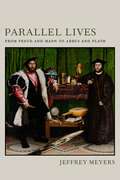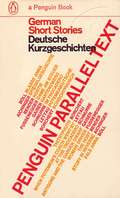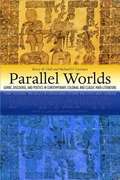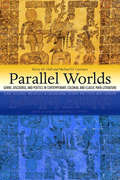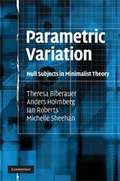- Table View
- List View
Paradise Lost (Routledge Library Editions: Milton #4)
by G. K. HunterFirst published in 1980. Paradise Lost was once a favourite text for family reading; today it is confined to the educational system, which treats it as an object to be investigated rather than a subject that demands response. Professor Hunter writes inevitably for an audience of literary students, but he invites them to consider Paradise Lost as a text that must be enjoyed before it can be explained. He understands the need to explain complexities, but is mainly concerned with the onward flow of our engagement with an ancient poem. Milton’s narrative technique is explored as a system which both encourages and frustrates our native sense of story. His poetic power is shown to grow from our assent to its brilliant evocation of "as if" fictions. Milton is a master of audience manipulation, of dramatic tension and intellectual paradox. These characteristics are described in the context of the task the poem sets itself to tell the untellable and describe what no man has ever seen. The power of Milton’s art is traced through his rehandling of Homer and Virgil and in his daringly individual fidelity to scripture. Professor Hunter does not try to smooth away the contradictions inherent in Milton’s ambition to write an English classical Christian epic. He rather stresses the contradictions as cues to a properly alert reading. And this is what the book aims at above all a response to Paradise Lost which is alert to poetry and unintimidated by scholarship.
Paradise Lost (SparkNotes Literature Guide Series)
by SparkNotesParadise Lost (SparkNotes Literature Guide) by John Milton Making the reading experience fun! Created by Harvard students for students everywhere, SparkNotes is a new breed of study guide: smarter, better, faster. Geared to what today's students need to know, SparkNotes provides: *Chapter-by-chapter analysis *Explanations of key themes, motifs, and symbols *A review quiz and essay topicsLively and accessible, these guides are perfect for late-night studying and writing papers
Paradise Lost and the Classical Epic (Routledge Library Editions: Milton #2)
by Francis C. BlessingtonThis study, first published in 1979, explores the idea that all spheres of action - hell, heaven, and earth - of the classical epic is relevant to all parts of Paradise Lost. The author also examines the structure, style, and the narrator of the text. This title will be of great interest to students of Milton and English Literature.
Paradise Lost and the Cosmological Revolution
by Dennis DanielsonThis volume brings John Milton's Paradise Lost into dialogue with the challenges of cosmology and the world of Galileo, whom Milton met and admired: a universe encompassing space travel, an earth that participates vibrantly in the cosmic dance, and stars that are "world[s] / Of destined habitation. " Milton's bold depiction of our universe as merely a small part of a larger multiverse allows the removal of hell from the center of the earth to a location in the primordial abyss. In this wide-ranging work, Dennis Danielson lucidly unfolds early modern cosmological debates, engaging not only Galileo but also Copernicus, Tycho, Kepler, and the English Copernicans, thus placing Milton at a rich crossroads of epic poetry and the history of science.
Paradise Lost and the Making of English Literary Criticism (Routledge Studies in Renaissance Literature and Culture)
by David A. HarperParadise Lost and the Making of English Literary Criticism identifies the early reception of Paradise Lost as a site of contest over the place of literature in political and religious controversy. Milton’s earliest readers and critics (Dryden, Addison, Dennis, Hume, and Bentley) confronted a poem and author at odds with prevailing culture and the revanchist conservatism of the restored monarchy. Grappling with the epic required navigating Milton’s reputation as a “fanatick” who had called in print for Charles I’s execution, inveighed openly against monarchy on the eve of Charles II’s return, and held heretical views on the trinity, baptism, and divorce. Harper argues that foundational figures in English literary criticism rose to this challenge by innovating new ways of reading: producing creative (and subversive) rewritings of Paradise Lost, articulating new theories of the sublime, explaining the poem in the first substantial body of annotations for an English vernacular text, and by pioneering early forms of textual criticism and editing.
Paradise Lost: A Biography (Lives of Great Religious Books)
by Alan JacobsThe life and times of Milton&’s epic poem about Satan&’s revolt against God and humanity&’s expulsion from paradiseJohn Milton&’s Paradise Lost has secured its place in the pantheon of epic poems, but unlike almost all other works in the pantheon, it is intimately associated with religious doctrine and its implications for how we live our lives. For more than three centuries, it has been a flashpoint for arguments not just about Christianity but also about governance, rebellion and obedience, sexual politics, and what makes poetry great. Alan Jacobs tells the story of Milton&’s enduring poem, shedding light on its composition and reception and explaining why it resonates so powerfully with us today.Composed through dictation after Milton went blind in 1652, Paradise Lost centers on an ancient biblical answer to the eternal question of how evil came into the world. It has proved impossible to disentangle the defense or critique of the poem from attitudes toward Christianity itself. Does Christian theology entail monarchy or democracy? Are relations between the sexes thwarted by pompous and tyrannical men or by vain and disobedient women? Jacobs traces how generations of readers have grappled with these and other questions, along the way revealing how Milton&’s poem influenced novelists like Mary Shelley and Philip Pullman and has served as the inspiration for paintings, operas, comic books, and video games.An essential companion to Milton&’s poetic masterpiece, this book shows why Paradise Lost continues to serve as a mirror reflecting our own complex attitudes about power and authority, justice and revolt, and sin and salvation.
Paradiso
by DanteHaving plunged to the uttermost depths of Hell and climbed the Mount of Purgatory in parts one and two of the Divine Comedy, Dante ascends to Heaven in this third and final part, continuing his soul’s search for God, guided by his beloved Beatrice. As he progresses through the spheres of Paradise he grows in understanding, until he finally experiences divine love in the radiant presence of the deity. Examining eternal questions of faith, desire and enlightenment, Dante exercised all his learning and wit, wrath and tenderness in his creation of one of the greatest of all Christian allegories.
Paradiso: Poema Di Dante (1787) (Dover Thrift Editions: Poetry)
by Dante AlighieriThe last great literary work of the Middle Ages and the first important book of the Renaissance, Dante's Divine Comedy culminates in this third and final section, Paradiso. The 14th-century allegory portrays a medieval perspective on the afterlife, tracing the poet's voyage across three realms — Hell, Purgatory, and Paradise — to investigate the concepts of sin, guilt, and redemption. Expressed in sublime verse, the trilogy concludes with this challenging and rewarding venture into the dwelling place of God, angels, and the souls of the faithful.Guided by Beatrice, the incarnation of beatific love, Dante undergoes an intellectual journey from doubt to faith. Beatrice instructs the poet in scholastic theology as they pass through the nine spheres of Paradise to the Empyrean, a realm of pure light in which the redeemed experience the bliss of God's immediate presence. This edition features the renowned translation by American poet Henry Wadsworth Longfellow and serves as a companion volume to the Dover editions of Inferno and Purgatorio.
Paradox and Representation: Silenced Voices in the Narratives of Nakagami Kenji
by Machiko IshikawaHow can the "voiceless" voice be represented? This primary question underpins lshikawa's analysis of selected work by Buraku writer, Nakagami Kenji (1946-1992). In spite of his Buraku background, Nakagami's privilege as a writer made it difficult for him to "hear" and "represent" those voices silenced by mainstream social structures in Japan. This "paradox of representing the silenced voice" is the key theme of the book. Gayatri Spivak theorizes the (im)possibility of representing the voice of "subalterns," those oppressed by imperialism, patriarchy and heteronomativity. Arguing for Burakumin as Japan's "subalterns," Ishikawa draws on Spivak to analyze Nakagami' s texts.The first half of the book revisits the theme of the transgressive Burakumin man. This section includes analysis of a seldom discussed narrative of a violent man and his silenced wife. The second half of the book focuses on the rarely heard voices of Burakumin women from the Akiyuki trilogy. Satoko, the prostitute, unknowingly commits incest with her half-brother, Akiyuki. The aged Yuki sacrifices her youth in a brothel to feed her fatherless family. The mute Moyo remains traumatized by rape. lshikawa' s close reading of Nakagami's representation of the silenced voices of these sexually stigmatized women is this book's unique contribution to Nakagami scholarship.
Paradox in Public Relations: A Contrarian Critique of Theory and Practice (Routledge New Directions in PR & Communication Research)
by Kevin L. StokerParadox in Public Relations: A Contrarian Critique of Theory and Practice is a thought-provoking exploration of public relations, aiming to promote changes in meaning and perception by creating new meta-realities for public relations. The term “Public Relations” was embraced by early practitioners primarily because it sounded more professional than the often-pejorative alternatives. This book argues for a reframing of some of the popular realities associated with modern-day public relations and uses psychological and organizational change theory to critique paradoxes in public relations theory and practice. By examining public relations through the lens of paradox, we can begin to identify the logical fallacies that have inhibited progress and innovation in public relations practice and theory. The book explores the paradoxical nature of key concepts, including public interest, relationship management, accountability, stewardship, loyalty, community, and ethics. It also recommends new conceptualizations for understanding the field. This book will be of interest to media, communication, public relations, and advertising faculty and graduate students, particularly those interested in public relations theory and ethics. Scholars from other disciplines can also use this exploration of paradox in PR as a learning tool for identifying logical fallacies and inconsistencies.
Paradoxes of Emotion and Fiction (G - Reference, Information and Interdisciplinary Subjects)
by Robert J. YanalHow can we experience real emotions when viewing a movie or reading a novel or watching a play when we know the characters whose actions have this effect on us do not exist? This is a conundrum that has puzzled philosophers for a long time, and in this book Robert Yanal both canvasses previously proposed solutions to it and offers one of his own.First formulated by Samuel Johnson, the paradox received its most famous answer from Samuel Taylor Coleridge, who advised his readers to engage in a "willing suspension of disbelief." More recently, philosophers have argued that we are irrational in emoting toward fiction, or that we do not emote toward fiction but rather toward factual counterparts, or that we do not have real but only quasi-emotion toward fiction, generated by our playing games of make-believe. All of these proposed solutions are critically reviewed.Finding these answers unsatisfactory, Yanal offers an alternative, providing a new version of what has been dubbed "thought theory." On this theory, mere thoughts not believed true are seen as the functional equivalent of belief at least insofar as stimulating emotion is concerned. The emoter's disbelief in the actuality of components of the thoughts must be rendered relatively inactive. Such emotion is real and typically has the character of being richly generated yet unconsummated.The book extends this theory also to resolving other paradoxes arising from emotional response to fiction: how we feel suspense over what comes next in a story even when we are re-reading it for a second or third time; and how we take pleasure in narratives, such as tragedy, that excite unpleasant emotions such as fear, pity, or horror.
Paradoxes of Media and Information Literacy: The Crisis of Information
by Jutta Haider Olof SundinParadoxes of Media and Information Literacy contributes to ongoing conversations about control of knowledge and different ways of knowing. It does so by analysing why media and information literacy (MIL) is proposed as a solution for addressing the current information crisis. Questioning why MIL is commonly believed to wield such power, the book throws into sharp relief several paradoxes that are built into common understandings of such literacies. Haider and Sundin take the reader on a journey across different fields of practice, research and policymaking, including librarianship, information studies, teaching and journalism, media and communication and the educational sciences. The authors also consider national information policy proposals and the recommendations of NGOs or international bodies, such as UNESCO and the OECD. Showing that MIL plays an active role in contemporary controversies, such as those on climate change or vaccination, Haider and Sundin argue that such controversies challenge existing notions of fact and ignorance, trust and doubt, and our understanding of information access and information control. The book thus argues for the need to unpack and understand the contradictions forming around these notions in relation to MIL, rather than attempting to arrive at a single, comprehensive definition. Paradoxes of Media and Information Literacy combines careful analytical and conceptual discussions with an in-depth understanding of information practices and of the contemporary information infrastructure. It is essential reading for scholars and students engaged in library and information studies, media and communication, journalism studies and the educational sciences.
Paradoxes of Stasis: Literature, Politics, and Thought in Francoist Spain (New Hispanisms)
by Tatjana GajicParadoxes of Stasis examines the literary and intellectual production of the Francoist period by focusing on Spanish writers following the Spanish Civil War: the regime’s supporters and its opponents, the victors and the vanquished. Concentrating on the tropes of immobility and movement, Tatjana Gajić analyzes the internal politics of the Francoist regime and concurrent cultural manifestations within a broad theoretical and historical framework in light of the Greek notion of stasis and its contemporary interpretations. In Paradoxes of Stasis, Gajić argues that the combination of Francoism’s long duration and the uncertainty surrounding its ending generated an undercurrent of restlessness in the regime’s politics and culture. Engaging with a variety of genres—legal treatises, poetry, novels, essays, and memoir—Gajić examines the different responses to the underlying tensions of the Francoist era in the context of the regime’s attempts at reform and consolidation and in relation to oppositional writers’ critiques of Francoism’s endurance. By elucidating different manifestations of stasis in the politics, literature, and thought of the Francoist period, Paradoxes of Stasis reveals the contradictions of the era and offers new critical tools for understanding their relevance.
Paradoxy of Modernism
by Robert ScholesIn this lively, personal book, Robert Scholes intervenes in ongoing discussions about modernism in the arts during the crucial half-century from 1895 to 1945. While critics of and apologists for modernism have defined modern art and literature in terms of binary oppositions--high/low, old/new, hard/soft, poetry/rhetoric--Scholes contends that these distinctions are in fact confused and misleading. Such oppositions are instances of "paradoxy"--an apparent clarity that covers real confusion. Closely examining specific literary texts, drawings, critical writings, and memoirs, Scholes seeks to complicate the neat polar oppositions attributed to modernism. He argues for the rehabilitation of works in the middle ground that have been trivialized in previous evaluations, and he fights orthodoxy with such paradoxes as "durable fluff," "formulaic creativity," and "iridescent mediocrity. " The book reconsiders major figures like James Joyce while underscoring the value of minor figures and addressing new attention to others rarely studied. It includes twenty-two illustrations of the artworks discussed. Filled with the observations of a personable and witty guide, this is a book that opens up for a reader's delight the rich cultural terrain of modernism.
Paragraphs and Essays: With Integrated Readings (12th Edition)
by Kelly Brandon Lee BrandonThis classic text offers comprehensive, proven instruction in developmental writing. Paragraphs and Essays: With Integrated Readings is the higher-level companion to Sentences, Paragraphs, and Beyond in the bestselling two-book Brandon series. Instruction in this text--comprehensive, flexible, and relevant--is predicated on the idea that reading and writing are linked and that good writing is the product of thoughtful and systematic revision.
Paralelismos y paradojas: Reflexiones sobre música y sociedad
by Edward W. Said Daniel BarenboimUn libro de ideas originales y sorprendentes sobre música, política y cultura que despliega un derroche de inteligencia de dos grandes mitos de nuestra cultura contemporánea: Daniel Barenboim y Edward W. Said. El israelí Daniel Barenboim -director de la orquesta Sinfónica de Chicago y de la Ópera Estatal de Berlín- y el palestino-noreteamericano Edward Said -eminente crítico literario y comprometido analista del conflicto de Oriente Próximo- han cultivado desde hace muchos años una profunda amistad que se hace patente en el apasionado y cordial intercambio de ideas que tiene lugar en estas conversaciones. Barenboim y Said hablan, entre otras cuestiones, de las diferencias entre la escritura de prosa y la de la música, de políticos que tratan de llegar a acuerdos y de artistas que sólo se comprometen con su arte, del famoso director Furtwängler, de Beethoven como supremo compositor de sonatas, de Wagner, de maestros y discípulos y, sobre todo, del poder de la cultura para ir más allá de las barreras nacionales y las diferencias políticas.
Paraliterary: The Making of Bad Readers in Postwar America
by Merve EmreLiterature departments are staffed by, and tend to be focused on turning out, “good” readers—attentive to nuance, aware of history, interested in literary texts as self-contained works. But the vast majority of readers are, to use Merve Emre’s tongue-in-cheek term, “bad” readers. They read fiction and poetry to be moved, distracted, instructed, improved, engaged as citizens. How should we think about those readers, and what should we make of the structures, well outside the academy, that generate them? We should, Emre argues, think of such readers not as non-literary but as paraliterary—thriving outside the institutions we take as central to the literary world. She traces this phenomenon to the postwar period, when literature played a key role in the rise of American power. At the same time as American universities were producing good readers by the hundreds, many more thousands of bad readers were learning elsewhere to be disciplined public communicators, whether in diplomatic and ambassadorial missions, private and public cultural exchange programs, multinational corporations, or global activist groups. As we grapple with literature’s diminished role in the public sphere, Paraliterary suggests a new way to think about literature, its audience, and its potential, one that looks at the civic institutions that have long engaged readers ignored by the academy.
Parallel Curriculum Units for Language Arts, Grades 6-12
by Dr Jeanne H. Purcell Jann H. LeppienSample units demonstrate how to use the Parallel Curriculum Model to design high-quality curriculum in language arts. Each unit includes instructions, assessments, and skills/standards.
Parallel Lives: From Freud and Mann to Arbus and Plath
by Jeffrey MeyersParallel Lives covers the century from the birth of Sigmund Freud in 1856 to the death of Sylvia Plath in 1963. Written by the esteemed biographer and literary critic Jeffrey Meyers, the book includes European, American, and Russian authors and artists, film directors and actors, children and soldiers, friends and lovers, rivals and enemies. Drawing on the bifocal principle of dual composition in Plutarch, these brief lives are arranged in pairs to interact with each other and illuminate their subjects’ similarities, characters, and friendships. The linked structure of Parallel Lives allows several major figures—Sigmund Freud, Evelyn Waugh, Edmund Wilson, Vladimir Nabokov, Ernest Hemingway, and Seamus Heaney—to appear in multiple chapters. The most violent friendship ended when Verlaine shot Rimbaud and went to prison, and Rimbaud crawled back from Africa to die miserably in France. The most brilliant friendship broke up when Wilson attacked Nabokov’s edition of Alexander Pushkin. The most moving connection was Audrey Hepburn’s tender and sympathetic attachment to her soul-sister Anne Frank. Using mirror images reveals a new way to perceive these illustrious men and women. Each chapter shifts the focus back and forth between two subjects, comparing them, changing perspective, reevaluating similarities and contrasts. With vivid details and dramatic events, Meyers emphasizes the backgrounds, intellectual influences, and personality traits of his paired subjects. By examining the complex motives for irrational behavior ranging from deep affection to intense hostility, warm encouragement to bitter rivalry (sometimes together in the same chapter), Parallel Lives offers insights into the dynamics of complementary characters.
Parallel Text: Deutsche Kurzgeschichten
by Richard NewnhamMuch maligned in pre-war Germany, the short story enjoyed a creative rebirth in 1945. Initially imported by the Allies, the form also matched perfectly the prevailing mood of irony, objectivity and mistrust of the didactic. With the original German text running alongside English translations, this collection features stories from eight outstanding post-war authors including Heinrich Böll, Ilse Aichinger and Reinhard Lettau which students will find both educational and engrossing. Böll’s opening story 'Pale Anna' follows a soldier returning home, his situation comparable to that of the writer in the first months of peace: he knows no-one and has few words not linked to painful memories. This poignant narrative is followed by a variety of tales representing the diversity of the time and including satires, explorations of private obsessions and experiments in form and language.
Parallel Worlds: Genre, Discourse, and Poetics in Contemporary, Colonial, and Classic Maya Literature
by Michael D. Carrasco Kerry M. HullDespite recent developments in epigraphy, ethnopoetics, and the literary investigation of colonial and modern materials, few studies have compared glyphic texts and historic Maya literatures. Parallel Worlds examines Maya writing and literary traditions from the Classic period until today, revealing remarkable continuities across time. In this volume, contributions from leading scholars in Maya literary studies examine Maya discourse from Classic period hieroglyphic inscriptions to contemporary spoken narratives, focusing on parallelism to unite the literature historically. Contributors take an ethnopoetic approach, examining literary and verbal arts from a historical perspective, acknowledging that poetic form is as important as narrative content in deciphering what these writings reveal about ancient and contemporary worldviews. Encompassing a variety of literary motifs, including humor, folklore, incantation, mythology, and more specific forms of parallelism such as couplets, chiasms, kennings, and hyperbatons, Parallel Worlds is a rich journey through Maya culture and pre-Columbian literature that will be of interest to students and scholars of anthropology, ethnography, Latin American history, epigraphy, comparative literature, language studies, indigenous studies, and mythology.
Parallel Worlds: Genre, Discourse, and Poetics in Contemporary, Colonial, and Classic Maya Literature (G - Reference, Information And Interdisciplinary Subjects Ser.)
by Michael D. Carrasco Kerry M. HullDespite recent developments in epigraphy, ethnopoetics, and the literary investigation of colonial and modern materials, few studies have compared glyphic texts and historic Maya literatures. Parallel Worlds examines Maya writing and literary traditions from the Classic period until today, revealing remarkable continuities across time. In this volume, contributions from leading scholars in Maya literary studies examine Maya discourse from Classic period hieroglyphic inscriptions to contemporary spoken narratives, focusing on parallelism to unite the literature historically. Contributors take an ethnopoetic approach, examining literary and verbal arts from a historical perspective, acknowledging that poetic form is as important as narrative content in deciphering what these writings reveal about ancient and contemporary worldviews. Encompassing a variety of literary motifs, including humor, folklore, incantation, mythology, and more specific forms of parallelism such as couplets, chiasms, kennings, and hyperbatons, Parallel Worlds is a rich journey through Maya culture and pre-Columbian literature that will be of interest to students and scholars of anthropology, ethnography, Latin American history, epigraphy, comparative literature, language studies, indigenous studies, and mythology.
Parallelism and Prosody in the Processing of Ellipsis Sentences (Outstanding Dissertations in Linguistics)
by Katy CarlsonFirst Published in 2002. Routledge is an imprint of Taylor & Francis, an informa company.
Parallels, Interactions, and Illuminations
by Ersu DingThe first major work in Sino-Western comparative semiotics, Parallels, Interactions, and Illuminations is a trans-disciplinary and intercultural effort that makes intellectual connections not only across such diverse academic fields as epistemology, anthropology, linguistics, sociology, and cultural studies but also between Chinese and Western theories of the sign in the conviction that they can shed light on one another.In this groundbreaking work, Ersu Ding studies two traditions of semiotic realism, represented by Plato and Husserl in the West and by Mo Zi and Ouyang Jian in China. They share two fundamental assumptions with regard to meaning: that there exist ultimate qualities of things and states of affairs in the extrasemiotic world and that the meanings of words or other types of sign are derivatives of these essentials. A pioneering work that remains extraordinarily accessible, Parallels, Interactions, and Illuminations explores a wide range of issues, including inter-subjective negotiation of meaning, the relationship between metaphor and culture, and the production and dissemination of myths.
Parametric Variation: Null Subjects in Minimalist Theory
by Theresa Biberauer Anders Holmberg Ian Roberts Michelle SheehanParametric variation in linguistic theory refers to the systematic grammatical variation permitted by the human language faculty. Although still widely assumed, the parametric theory of variation has in recent years been subject to re-evaluation and critique. The Null Subject Parameter, which determines among other things whether or not a language allows the suppression of subject pronouns, is one of the best-known and most widely discussed examples of a parameter. Nevertheless its status in current syntactic theory is highly controversial. This book is a defence of the parametric approach to linguistic variation, set within the framework of the Minimalist Program. It discusses syntactic variation in the light of recent developments in linguistic theory, focusing on issues such as the formal nature of minimalist parameters, the typology of null-subject language systems and the way in which parametric choices can be seen to underlie the synchronic and diachronic patterns observed in natural languages.
